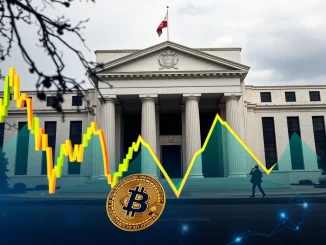
The cryptocurrency market is known for its volatility, and monitoring key price levels is crucial for traders and investors alike. Recent data highlights a critical threshold for Bitcoin that could unleash significant market movement. If Bitcoin drops below $106,000, we could see a cascade of **Bitcoin liquidations** totaling over $1 billion. This potential event underscores the importance of understanding leverage and market dynamics in the crypto space.
Understanding Bitcoin Liquidations
What exactly are **Bitcoin liquidations**? In simple terms, liquidation occurs when a trader’s leveraged position is forcibly closed by an exchange. This happens because the trader’s margin (the collateral used to open the position) is no longer sufficient to cover potential losses as the price moves against their bet. For example, if a trader is ‘long’ (betting the price will go up) with leverage, and the price falls significantly, their position will be liquidated to prevent their balance from going negative.
Conversely, if a trader is ‘short’ (betting the price will go down) with leverage, and the price rises sharply, their short position will be liquidated. Liquidations are a common feature of leveraged trading on centralized exchanges (CEXs) and play a significant role in market volatility, as large liquidation events can add selling or buying pressure, potentially accelerating price moves.
Analyzing the CoinGlass Data: The $1B+ Threshold
According to data cited by JinSe Finance, sourced from the popular analytics platform CoinGlass, the levels around $106,000 and $109,000 represent significant clusters of leveraged positions. This **CoinGlass data** provides valuable insight into where potential liquidation points lie:
- Below $106,000: A drop to or below this level could trigger approximately $1.07 billion in long liquidations. This means traders who have borrowed funds to bet on Bitcoin’s price *increasing* would see their positions automatically closed out. The forced selling from these liquidations could potentially push the price down further.
- Above $109,000: Conversely, a move above this level could trigger around $1.157 billion in short liquidations. Traders who have borrowed funds to bet on Bitcoin’s price *decreasing* would face liquidation. The forced buying from these closures could potentially fuel a price rally.
These figures highlight the substantial amount of leverage currently in the market around these price points. Crossing either threshold could act as a catalyst for accelerated price action in that direction.
Why Crypto Liquidations Matter for the Market
Large-scale **crypto liquidations**, like the potential $1B+ events discussed, have a significant impact on the broader market. When a large number of positions are liquidated simultaneously, it creates a rush of market orders (sell orders for long liquidations, buy orders for short liquidations). This sudden influx of orders can overwhelm market depth, leading to rapid price drops (in the case of long liquidations) or surges (in the case of short liquidations).
This phenomenon can create a ‘liquidation cascade’ or ‘short squeeze’. A liquidation cascade occurs when initial liquidations push the price further, triggering more liquidations, and so on, creating a downward spiral. A short squeeze happens when short liquidations force buying, driving the price up rapidly and triggering even more short liquidations. Understanding these dynamics is key to navigating volatile markets.
Navigating Bitcoin Price Volatility: Strategies for Traders
Given the potential for sharp moves around these levels, how can traders and investors approach the current **Bitcoin price** environment? Here are some strategies and considerations:
- Risk Management is Paramount: For those using leverage, setting appropriate stop-loss orders is crucial. A stop-loss order automatically closes your position if the price reaches a certain level, limiting potential losses and preventing liquidation.
- Monitor Key Levels: Keep a close eye on the $106,000 and $109,000 levels. A break of either level could signal the start of a significant move.
- Understand Your Leverage: Be aware of how much leverage you are using and how close your liquidation price is to the current market price. Higher leverage means greater risk of liquidation with smaller price movements.
- Consider Lower Leverage or Spot Trading: For those uncomfortable with the risks of liquidation, trading with lower leverage or sticking to spot trading (buying and selling the actual asset without borrowing) can be safer alternatives.
- Stay Informed: Follow market news and data sources like CoinGlass to understand where large pockets of liquidity and potential liquidation points exist.
Understanding Trading Liquidations on CEXs
**Trading liquidations** primarily occur on centralized cryptocurrency exchanges that offer margin and futures trading. These platforms allow users to trade with borrowed funds, amplifying potential profits but also potential losses. The exchange’s liquidation engine constantly monitors leveraged positions. If a position’s margin level falls below the required maintenance margin, the engine automatically liquidates the position to protect the exchange and other users from losses. The specific liquidation price for a position depends on the leverage used, the entry price, and the maintenance margin requirement of the exchange.
While liquidations are a risk for individual traders, large clusters of potential liquidations, as highlighted by the **CoinGlass data**, become a systemic risk factor that can impact overall market stability and price discovery.
Conclusion
The potential for over $1 billion in **crypto liquidations** around the $106,000 and $109,000 Bitcoin price levels serves as a stark reminder of the leveraged nature of the crypto market. Data from platforms like CoinGlass offers valuable insights into these potential market catalysts. For anyone involved in trading, especially with leverage, understanding where these significant liquidation clusters lie and implementing robust risk management strategies is essential to navigating the inherent volatility and protecting capital in the dynamic world of Bitcoin and cryptocurrencies.



